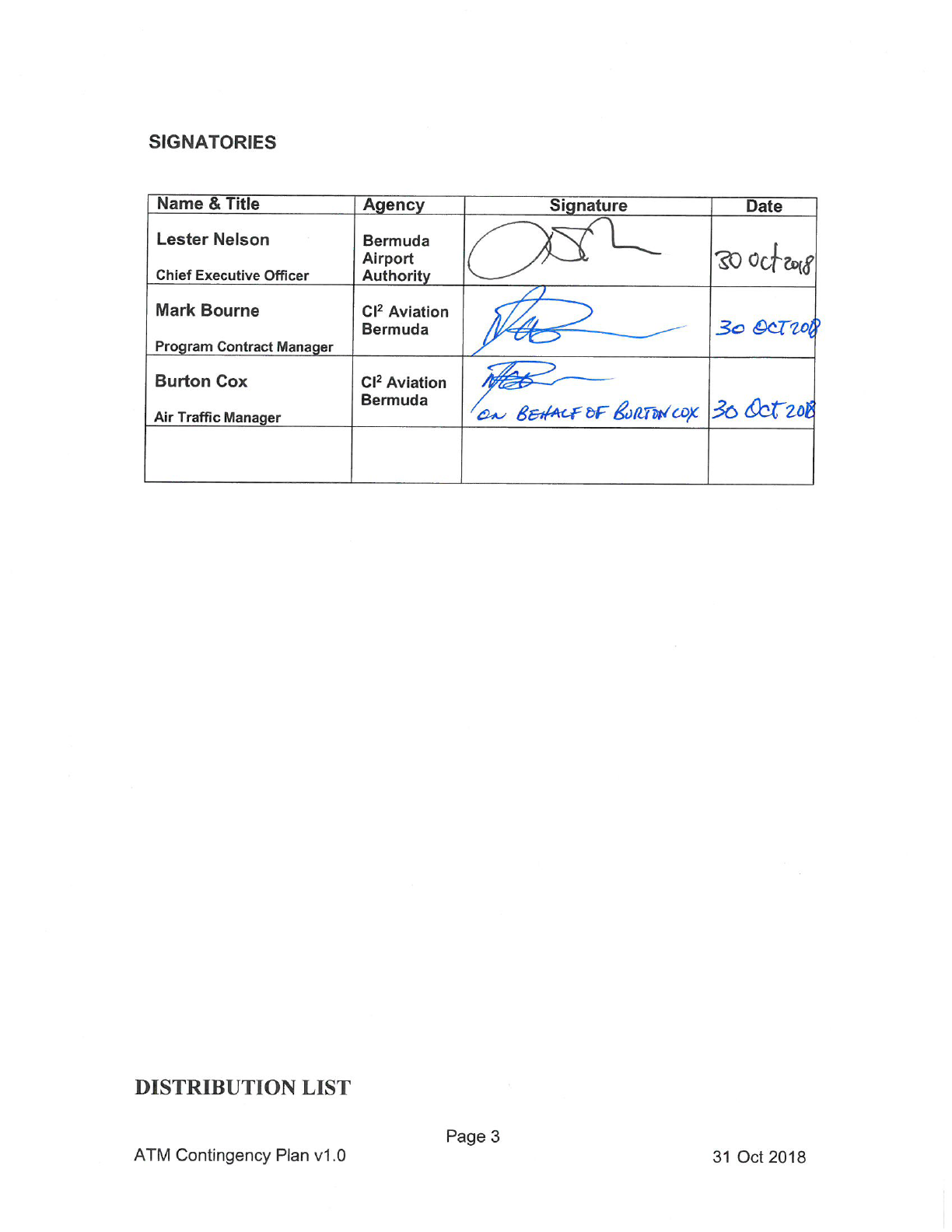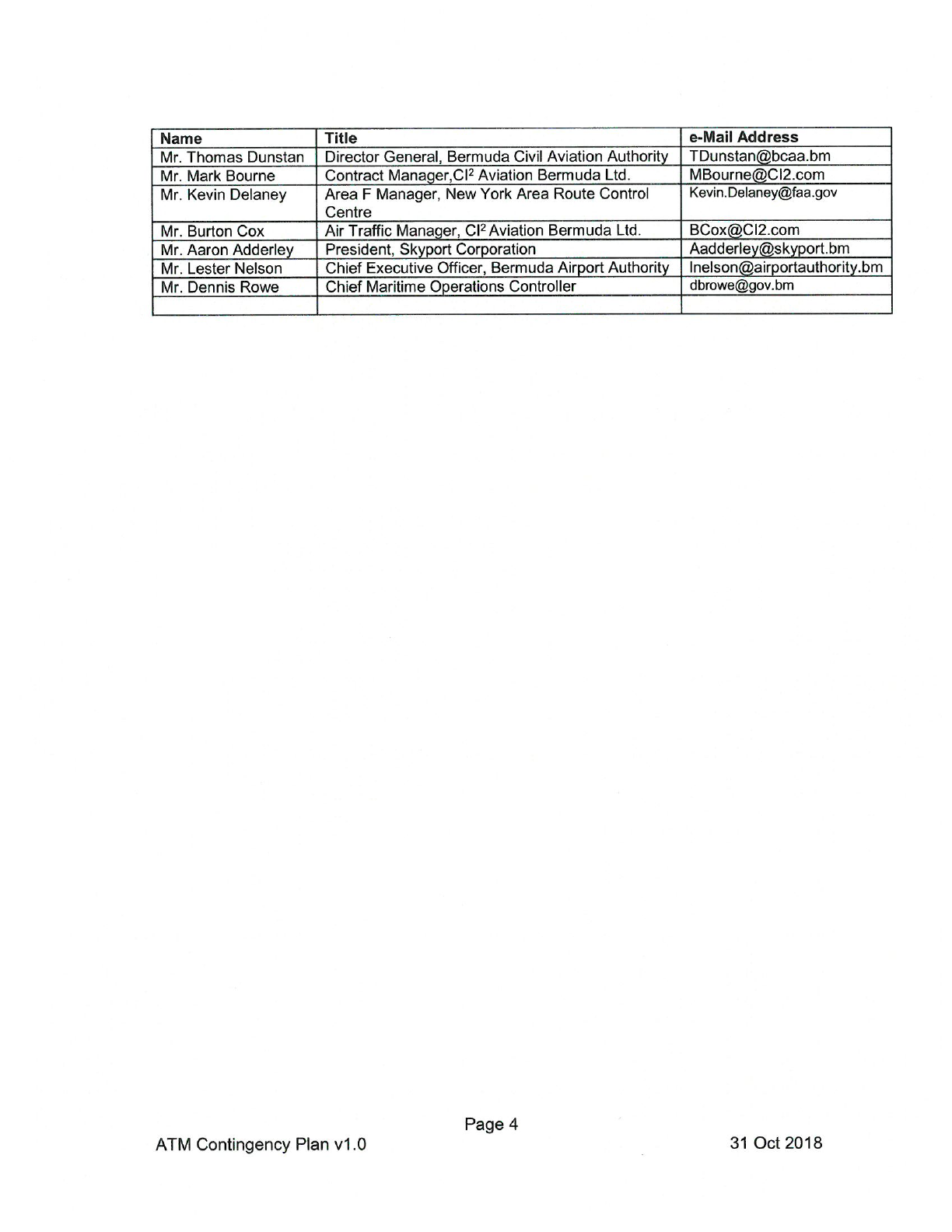
Air Traffic Management Contingency Plan
BERMUDA TOWER
Version 1.0
Page 2
ATM Contingency Plan v1.0 31 Oct 2018
Contents
SIGNATORIES ................................................................................................................ 3
DISTRIBUTION LIST………………………………………………………………...………….4
FOREWORD ................................................................................................................... 5
RECORD OF AMENDMENT…………………………………………………………………...6
1. ATM CONTINGENCY PLAN FOR BERMUDA TOWER............................................... 7
2. AIR TRAFFIC CONTROL FACILITIES AFFECTED .................................................... 7
3. MANAGEMENT OF THE CONTINGENCY PLAN ....................................................... 7
4. CONTINGENCY ROUTES AND PROCEDURES ....................................................... 9
5. AIR TRAFFIC MANAGEMENT AND CONTINGENCY PROCEDURES ...................... 9
6. ATS RESPONSIBILITIES .......................................................................................... 12
7. AIRSPACE CLASSIFICATIONS ................................................................................ 13
8. AIRCRAFT POSITION REPORTING ........................................................................ 13
9. PROCEDURES FOR ATS UNITS ............................................................................. 14
10. TRANSITION TO AND FROM CONTINGENCY OPERATIONS .............................. 14
11. TRANSFER OF CONTROL AND COORDINATION ................................................ 15
12. PILOT AND OPERATOR PROCEDURES ............................................................... 15
13. COMMUNICATION PROCEDURES ....................................................................... 16
14. AERONAUTICAL SUPPORT SERVICES................................................................ 16
15. SEARCH AND RESCUE ALERTING ...................................................................... 17
Appendix A - Contact Details ......................................................................................... 19
Appendix B - Specimen NOTAMs ................................................................................. 20
Appendix C - Contingency Activity Log .......................................................................... 21



Page 5
ATM Contingency Plan v1.0 31 Oct 2018
FOREWORD
1. This Contingency Plan forms part of the overall national contingency planning for
domestic and international flights in Bermuda has been prepared in accordance with the
provisions of Annex 11 to the Convention on Civil Aviation, ICAO Doc 9462, ATS
Planning Manual, Doc 9673 and ICAO Doc ATM 4444. The Plan, and any activation of
the Plan, is authorised by the Bermuda Civil Aviation Authority (BCAA).
2. The Plan provides for the safe continuation of air traffic within the Bermuda Class D
Airspace during periods when ATS may be disrupted or unavailable, or when airspace or
aerodrome may be affected by volcanic ash cloud, radioactive cloud, and severe weather
events or military activity.
3. The Plan has been developed in cooperation and collaboration with airspace users
and civil aviation authorities responsible for adjacent airspaces and FIRs.
4. The Plan will be activated by NOTAM from the Bermuda NOTAM Office were
appropriate as far in advance as is practicable. In case the Bermuda NOTAM office is
unable to issue the NOTAM then New York Area Route Control Centre will be requested
using the most expeditious alternative means available for issuance of a NOTAM for
activation of the Plan. It is expected that Bermuda Civil Aviation Authority, the Bermuda
Airport Authority, Bermuda Skyport Corporation the aerodrome operator, and airline
operators will fully cooperate to implement the Contingency Plan.
.
Any Proposals for amendments to this plan may be forwarded to:
Burton Cox
Air Traffic Manager, CI
2
Aviation Bermuda Ltd.
Bermuda Tower
#0629 Southside, St Georges
Bermuda
Tel: 1 441 293 5067 Ext. 300
Fax: 1 441 293 0423
Email: bcox@ci2.com

Page 6
ATM Contingency Plan v1.0 31 Oct 2018
RECORD OF AMENDMENTS
Amendment
Number
Effective
Date
Date
Entered
Entered
By
Paragraph/
Reference
Page 7
ATM Contingency Plan v1.0 31 Oct 2018
1. ATM CONTINGENCY PLAN FOR BERMUDA TOWER
OBJECTIVE
1.1 The Air Traffic Management (ATM) Contingency Plan for the Bermuda Tower details
arrangements to ensure the continued safety of air navigation in the event of partial or
total disruption of air traffic services in the Bermuda Class D airspace or at LF Wade
International Airport. Air Traffic Control (ATC) Service is provided for LF Wade
International Airport Bermuda from an ATC tower. The Bermuda Tower is responsible for
providing all air traffic services for arrivals, departures, and overflights, to include VFR
and SVFR operations entering, exiting or operating within the Bermuda Class D airspace
in accordance with ICAO Annex 11 ─ Air Traffic Services. Departure and Arrival
control is provided by New York Air Route Traffic Control Center (NYARTCC) located on
Long Island, New York using a surveillance radar, radio transmitters and receivers
installed in Bermuda. Bermuda Class D Airspace extends up to and including 2,500 ft
AGL, within a 4.4 nautical mile radius of the LF Wade International Airport Bermuda,
extending to 7 nautical miles WNW and ESE respectively from the BDA VHF Omni-
directional Range/Distance Measuring Equipment (VOR/DME).The Contingency Plan
provides the ATS procedures that will allow aircraft operators to operate within Class
D Airspace during periods of limited or no ATS, as far as is practicable.
1.2 Contingency plans are established in the event of a disruption or potential disruption
of air traffic control services and related supporting services in the Bermuda Class D/E
airspace and adjacent airspace.The contingency procedures which are also documented
in the Bermuda Tower, Manual of Air Traffic Services (MATS) to include the following
inter alia; unlawful interference, power communications failure, tower evacuation
procedures, contingency for staffing levels, overdue aircraft, radio communication failure
and non-tower operations covered by the Bermuda Tower and NYARTCC LoA.
2. AIR TRAFFIC CONTROL FACILITIES AFFECTED
2.1 In the event that Bermuda Tower activates this Contingency Plan, the NYARTCC will
be notified in accordance with the NYARTCC/ Bermuda Tower Letter of Agreement. The
FIR and ACC directly affected by this Contingency Plan is as follows:
a) US FAA New York Air Route Traffic Control Center (NYARTCC)
2.2 The contact details of the NYARTCC are contained in Appendix A. These details
should be kept up to date and regularly reviewed.
3. MANAGEMENT OF THE CONTINGENCY PLAN
3.1 The contingency measures set out in this Plan are applicable in cases of
p la n ned an d unexpected interruptions in ATS caused by natural occurrences or
other circumstances, which, in one way or another, may impair or totally disrupt the
provision of ATS and/or of the related support services in the Bermuda Class D
Airspace and also when Bermuda Class D Airspace reverts to Bermuda Class E
Airspace during non-tower operations.

Page 8
ATM Contingency Plan v1.0 31 Oct 2018
3.2 The following arrangements have been put in place to ensure that the management
of the Contingency Plan provides for flights to proceed in a safe and orderly fashion
within the Class D/E Airspace, as far as practicable.
3.3 As soon as practicable in advance of, or after a contingency event has occurred, the
following agencies will be notified as appropriate by the Air Traffic Manager or his/her
designated representative :
1) CI
2
AVIATION BERMUDA LTD – Contract Manager
2) BERMUDA CIVIL AVIATION AUTHORITY – Aerodrome Inspector
3) NEW YORK AIR ROUTE TRAFFIC CONTROL CENTER – Area F Manager
4) BERMUDA SKYPORT CORPORATION LTD – Director, Airport Operations
NB. At the discretion of the aerodrome operator (Skyport Corporation) the
Emergency Coordination Centre may be convened in accordance with the Airport
Emergency Plan, either immediately, or at any time during the implementation of
Contingency Plan.
5) BERMUDA AIRPORT AUTHORITY– Director, Airport Services Delivery
6) BERMUDA RESCUE COORDINATION CENTER – Chief Maritime Operations
Controller or Duty Officer
3.4 Terms of Reference for these agencies and the contact details of its members are
provided in Appendix A.
3.5 The Air Traffic Manager will be responsible for the overseeing of the day to day
operations under the contingency arrangements, and coordinate operational ATS
activities, during hours of operation, throughout the contingency period and keep all
stakeholders informed.
The Air Traffic Manager functions shall include but not limited to the following:
a).Review and update of the Contingency Plan as required;
b).Keep up to date regarding the contingency situation;
c).Organise contingency teams in each of the specialised areas;
d).Keep in contact with and update all affected airspace and system users,
customers and other relevant stakeholders.
e).Exchange up-to-date information with the adjacent ATS authorities
concerned to coordinate contingency activities;

Page 9
ATM Contingency Plan v1.0 31 Oct 2018
f).Notify the designated organisations of the contingency situation sufficiently
in advance and/or as soon as possible thereafter;
g).Take necessary action for issuing NOTAMs according to this plan or as
otherwise determined by the contingency situation. Where the contingency
situation is sufficiently foreseeable the relevant NOTAMs will be issued 48
hours in advance of the contingency events. NOTAM templates are provided
in Appendix B.
h).Maintain an activity log using the form in Appendix C.
4. CONTINGENCY ROUTES AND PROCEDURES
4.1 In the event of disruption of the ATC services provided by Bermuda Tower,
contingency routes and procedures will be specified to ensure safety of flight and to
facilitate limited flight operations commensurate with the prevailing conditions. Existing
ATS routes and procedures form the basis of the contingency routes and procedures
to be used, and additional Prior Permission Request (PPR restrictions may be applied to
limit the number of aircraft operating simultaneously in the system under reduced air
traffic services. Additional unpublished contingency routes and procedures may be
developed tactically by the AOCG and promulgated by NOTAM as and when
circumstances require, such as in the case of volcanic ash cloud, radioactive cloud or
severe weather event. Any such amendments to routes and procedures will be notified
to, and agreed with, New York Air Route Traffic Control Centre as appropriate.
If circumstances dictate, flights that have not yet departed may be temporarily suspended
until a full assessment of the prevailing conditions has been determined and sufficient air
traffic services restored. A decision to curtail or restart these operations will be made by
the CCC.
5. AIR TRAFFIC MANAGEMENT AND CONTINGENCY PROCEDURES
The following emergency procedures include contingency plans established in the event
of a disruption or potential disruption of air traffic control services and related supporting
services in the Bermuda Class D airspace and the adjacent portions of airspace.
These established procedures take into account the guidance material contained in
Attachment C of ICAO Annex 11 and ICAO Doc 4444.
5.1 BERMUDA TOWER – EVACUATION PROCEDURES
The decision to evacuate the Control Tower may be made by the Air Traffic Manager,
the ATCS on duty, Skyport, or BFRS/AOD. In all circumstances, the safety of personnel
is paramount.
Evacuation - Immediate Actions. If it becomes necessary to evacuate the Tower, the
following procedures will apply:
Page 10
ATM Contingency Plan v1.0 31 Oct 2018
a). Broadcast on all Aerodrome and Ground frequencies to inform all aircraft and
vehicle traffic that the Tower is closing and that control services are terminated
until further notice. Have all aircraft monitor Ground Control frequency 124.5MHz;
except instruct all arriving aircraft on frequency 118.1MHz to contact NYARTCC;
b). Inform NYARTCC, BFRS/AOD, ADO, BWS and Air Traffic Manager via direct
lines and/or the commercial telephone; inform NYARTCC of the any arriving
aircraft returning to frequency 128.5MHz with position information. Direct
BFRS/AOD to monitor the Hytera Radio System, and to keep all unnecessary
vehicles off of the manoeuvring area. Advise NYARTCC of Tower cell phone
number;
c). If time permits, contact the ATM, engage the ARCAL system, and, if
necessary notify the relevant emergency services by telephone # 911;
d). Using the checklist located in the ATC evacuation tote bag, take the URC-200
UHF/VHF Transceiver and spare batteries, the current daily traffic strips, the
Daily Record of Facility Operation, the portable Hytera radio, the Tower cell
phone and any items that can be safely carried, e.g. binoculars, strip holders,
and personal items. Note: If unable to transport the URC -200 unit, ensure
unit batteries and spare batteries are taken;
e). Exit the Tower via the stairwell or the exterior fire escape, as necessary.
Conduct a sweep of all floors and evacuate any other personnel;
f). Proceed to the BWS building and establish a temporary communications unit
inside the building in the Meteorological Observer area; use the RES-Q unit
located at in the Observers Area and the spare URC-200 unit located at GES as
required. Establish control services on frequency 118.10MHz, 124.5MHz and
121.50MHz and recover all traffic. Suspend all departures as necessary. Use the
evacuation kit located in the ATC evacuation tote bag. It contains pens/paper/clip
boards and traffic sheets;
g). Notify Help Desk and GES of Tower evacuation;
h). According to air traffic operations/levels and estimated duration of ATC Tower
unavailability, determine the need for a mobile communications unit. If necessary
contact BFRS/AOD and coordinate the use of the BFRS/AOD mobile command
vehicle and a driver for use as a mobile ATC unit, and relocate to a site on the
airfield;
i). Once all aircraft have been recovered, the Air Traffic Manager will liaise with
the CI
2
Aviation Bermuda.
During the contingency period ATS including ATC may not be available. In cases where
services are not available, a NOTAM will be issued providing the relevant information,
including an expected date and time of resumption of service. The Contingency Plan
provides for limited flight information and alerting services to be established by the
Bermuda Tower.

Page 11
ATM Contingency Plan v1.0 31 Oct 2018
5.2 TOWER POWER COMMUNICATION FAILURE – PROCEDURES
Should a total communication failure occur, controllers shall use the URC 200 UHF/VHF
Transceiver to recover air traffic, and the portable Hytera Radio to recover vehicular
traffic, and the Tower cell phone as required.
Aerodrome Control frequency 118.10 MHz shall be notified to all aircraft under Bermuda
Tower control, as the single control frequency; ATCSs shall also notify NYARTCC.
If the Tower has a total power/communication failure:
a). The ATCS shall phone NYARTCC 631-468-1496, advising the NYARTCC Area
Manager immediately of the failure and that all future coordination will be carried out by
landline/cell phone; provide NYARTCC with current Tower cell phone number; and
b). The ATCS shall advise the BFRS/AOD, ADO and BWS of the situation, the last
active runway in use and that crash response instructions will be via landline/cell
phone/Hytera Radio; provide all agencies with current Tower cell phone number.
c). The ATCS shall advise the CI
2
Aviation Bermuda, Ltd. Help Desk and GES of the
power outage.
d). Once power/communications are restored, Tower shall notify NYARTCC Area
Manager, BFRS/AOD, ADO and BWS.
5.3. RADIO COMMUNICATION FAILURE - AIRCRAFT
In the event of lost communications with an aircraft under your control, or failure to
establish communications with an aircraft in Bermuda Class D airspace, use all
appropriate means available to establish/re-establish contact. This may include, but is
not limited to, the use of emergency frequencies and assistance from NYARTCC.
Confirmation of two-way radio communications failure by a pilot of a transponder-
equipped aircraft may be achieved by signalling a Mode3/A Code of 7600.
In the event that communications cannot be restored or established, appropriate control
clearances shall be given to aircraft using the ATC light gun.
5.4 SEVERE WEATHER
a). The Tower shall notify GES whenever the surface wind is 75 knots or more and/or
forecasted to exceed 75 knots; and,
b). During such weather conditions the Tower shall notify the NYARTCC sector ATCS
that the radar antenna is going to be turned off by GES due to the high winds.
Additionally, the Tower shall transmit an updated Airport Facilities Status Report to the
ADO.
c). The NAS Operations Manager Desk at NYARTCC will be notified by GES. GES will
also request BWS to issue an appropriate NOTAM.
d). Whenever the Thorguard lighting prediction system alarm activates, all apron
operation shall cease, and ATCS under the direction of the ADO shall instruct arriving
aircraft to hold short of the Aprons.

Page 12
ATM Contingency Plan v1.0 31 Oct 2018
e). Hurricane season runs from 01 June to 30 November each year. It is imperative that
all ATCSs apply the procedures detailed in CI
2
Aviation Bermuda, Ltd.’s Hurricane
Preparedness Plan as amended. A copy is located in the Ready Reference File.
5.5 CONTINGENT STAFFING
Staffing challenges are created by short term and or long term, planned or unplanned
staffing absences, which can be caused by an illness/fatality, a family emergency, or
employment termination.
The BDA ATCT requires a minimum of four ATCS to operate the facility the normal
scheduled hours. This schedule would not be used for a period that exceeds three
months. This schedule would not require an ATCS to exceed the MATS 200 hour’s
maximum in 31 days.
To quickly respond to an unplanned staffing shortage, the CI
2
Aviation Bermuda,
Contract Manager will maintain a Bermuda ATC License and Aerodrome rating and will
act as a reserve ATCS. The Contract Manager’s minimum monthly currency requirement
is five hours for every 31 days.
5.6 STANDARD INSTRUMENT DEPARTURES AND STANDARD ARRIVAL ROUTES
Standard instrument departures (SIDs) and standard arrival routes (STAR) have been
implemented at TXKF. The dedicated SID phraseology allows ATC and aircrew to
communicate and understand detailed clearance information that would otherwise
require long and potentially complex transmissions during non-radar periods. Therefore
increasing the efficiency of ATC during non-radar periods.
During non-radar periods the Bermuda Tower in coordination with NYARTCC will issue a
detailed NOTAM to notify aircrews that the SID procedures are in effect in accordance
with the NYARTCC and Bermuda Tower Letter of Agreement.
The Bermuda Tower will issue SIDs to aircraft departing TXKF during non-radar periods.
Pilots may request or file SIDs during radar periods.
6. ATS RESPONSIBILITIES
6.1 In the event that ATS cannot be provided in the Bermuda Class D/E Airspace a
NOTAM shall be issued indicating the following where appropriate:
a) Time and date of the beginning of the contingency measures;
b) Airspace available for landing and overflying traffic and airspace to be avoided;
c) Details of Air Traffic Services available or not available and any limits of services
including an expected date of restoration of services if available;
Page 13
ATM Contingency Plan v1.0 31 Oct 2018
d) Information on the provisions made for alternative services;
e) Applicable ATS routes and procedures, AIP-published, or tactically defined
contingency routes or procedures.
f) Any special procedures to be followed by NYARTCC or Bermuda Tower not covered
by this Plan;
g) Any special procedures to be followed by pilots; and
h) Any other details with respect to the disruption and actions being taken that
aircraft operators may find useful.
6.2 Sample NOTAMs provided in APPENDIX B.
6.3 In the event that the Bermuda Weather Service is unable to issue the NOTAM, the
alternate International NOTAM Office at New York Flight Centre will take action to issue
the contingency NOTAM upon notification by the Bermuda Weather Service.
7. AIRSPACE CLASSIFICATIONS
7.1 Depending on the degree of disruption, airspace classifications may be changed to
reflect the reduced level of services. Changes to airspace classification will be notified by
NOTAM.
8. AIRCRAFT POSITION REPORTING
8.1 Pilots will continue to make or broadcast routine position reports in line with normal
ATC reporting procedures.
8.2 Traffic information Broadcast by aircraft CTAF procedures shall apply when
Bermuda Tower is unmanned. There are CTAF procedures for Bermuda Class E
airspace, pilots shall transmit their intentions on CTAF, details of CTAF procedures
and communications requirements are provided in ICAO Annex 11 and the Bermuda AIP
Section AD 2.20 (15) respectively.
8.3 The CTAF frequency shall be as follows:
Bermuda Class E airspace – 122.8 MHz;
Page 14
ATM Contingency Plan v1.0 31 Oct 2018
9. PROCEDURES FOR ATS UNITS
9.1 Bermuda Tower will follow their unit emergency and contingency operating
procedures and activate the appropriate level of contingency procedures in line with
MATs, this Plan and any other relevant LoAs or MoUs.
a). Where ATS provided by Bermuda Tower may be reduced or disrupted by a
short-notice contingency event, ATC will inform pilots of the emergency condition and
advise if it is likely that the ATC facility will be evacuated and ATS suspended. In
the event of it becoming necessary to evacuate the building, the unit evacuation
procedures will be activated, and time permitting, controllers will make an emergency
evacuation transmission on the radio frequency in use, providing pilots with alternate
means of communication;
b). During the period the contingency procedures are in effect, flight plan and other
aircraft movement messages must continue to be transmitted by operators to NYARTCC
(KZWYZOZX)/(KZWYZQZX) and the Bermuda Tower via (TXKFZGZX) the AIS-R using
normal procedures;
c). On notification by Bermuda Tower, NYARTCC, as appropriate, will activate any of the
contingency procedures agreed via a LoA or MoU.
d). Prior to entry to the Class D airspace during contingency operations, PPRs must be
obtained from the airport operator, Bermuda Skyport Corporation Ltd., and flights must
comply with the ATC clearances, procedures and communication instructions issued
by NYARTCC.
e). Coordination of aircraft boundary estimates and levels by NYARTCC, the unit
responsible for aircraft entering the Bermuda Class D airspace, shall be in accordance
with the agreed procedures as detailed in an LoA or MoU or as otherwise agreed as part
of the contingency operations.
10. TRANSITION TO AND FROM CONTINGENCY OPERATIONS
10.1 Alternate routes would be promulgated by NYARTCC to Bermuda Tower to
operators. During times of uncertainty when the airspace closures seem possible, aircraft
operators should be prepared for a possible change in routing while en-route.
10.2 In the event of airspace closure that has not been promulgated, ATC should,
if possible, broadcast to all aircraft in their airspace, what airspace is being closed and
to stand by for further instructions.
10.3 ATS providers should recognize that when closures of airspace or airports are
promulgated, individual airlines might have different company requirements as to their
alternative routings. ATC should be ready to respond to any request by aircraft and
react commensurate with safety.
Page 15
ATM Contingency Plan v1.0 31 Oct 2018
11. TRANSFER OF CONTROL AND COORDINATION
11.1 Unless otherwise specified in the Plan, relevant LoA or MoU or agreed tactically as
part of the contingency operation, transfer of control and communication should be in
accordance with standard operating procedures.
11.2 The concerned ATS providers will review the effectiveness of current coordination
requirements and procedures in light of contingency operations or short notice of
airspace closure, and make any necessary adjustments to the Contingency Plan and
LOAs.
12. PILOT AND OPERATOR PROCEDURES
12.1 Flight planning requirements for TXKF continue to apply during contingency
operations, except where modified by the contingency procedures specified by ATC
and/or by NOTAM.
12.2 Aircraft operators must obtain PPR from the airport operator Bermuda Skyport
Corporation prior to operating flights w i t h i n the Class D airspace. During the
period of activation of this Contingency Plan, NYARTCC will provide normal ATC
clearances for aircraft to enter the Class D airspace. NYARTCC is not responsible
for coordination or provision of PPR for the Bermuda Class D airspace. The
operator must ensure any PPR has been obtained.
12.3 Pilots will continue to make or broadcast routine position reports in line with normal
ATC reporting procedures and use the CTAF frequency as required.
12.4 Pilots of aircraft operating in the Bermuda Class D airspace during contingency
operations shall comply with the following procedures:
a).Flights are to file flight plans using any specified contingency routes according to their
airport of origin and destination;
b). Aircraft are to operate as close as possible to any assigned contingency route;
c). A continuous communications watch shall be maintained on the contingency
frequency as notified
d). In the absence of the Bermuda Tower, aircraft position reports and other information
shall be broadcast in accordance with CTAF procedures defined in Bermuda AIP.
e). Aircraft navigation and anti-collision lights shall be displayed;
f). Except in cases of emergency or for reasons of flight safety, pilots are to, during
their entire flight within Bermuda Class D airspace, comply with any ATC clearance
specified.
Page 16
ATM Contingency Plan v1.0 31 Oct 2018
g). Not all operational circumstances can be addressed by this Contingency Plan and
pilots are to maintain a high level of alertness when operating in the contingency
airspace and take appropriate action to ensure safety of flight.
h).Pilots shall continuously guard the VHF emergency frequency 121.5 MHz and should
operate their transponder during flight, regardless of whether the aircraft is within or
outside airspace where secondary surveillance radar (SSR) is used for ATS purposes.
Transponders should be set on the last discrete code assigned by ATC or select
code [7700] if no code was assigned.
13. COMMUNICATION PROCEDURES
DEGRADATION OF COMMUNICATION - PILOT RADIO PROCEDURES
13.1 When operating within the contingency airspace, pilots should use normal radio
communication procedures where ATS services are available. Where limited or no ATS
is available communications conducted will be in accordance with the communication
procedures in this Plan, or as otherwise notified by NOTAM.
13.2 If communications are lost unexpectedly on the normal ATS frequencies, pilots
should try the next applicable frequency. Pilots should also consider attempting to contact
ATC on the last frequency where two-way communication had been established. In the
absence of communication with ATC, the pilot should continue to make routine position
reports on the assigned frequency, and broadcast positions in accordance with the TIBA/
CTAF procedures.
14. AERONAUTICAL SUPPORT SERVICES
AERONAUTICAL INFORMATION SERVICES (AIS)
AIS is provided in accordance with Annex 15 through the Bermuda Airport Authority. The
Bermuda Weather Service provides NOTAM services and limited filing of flight plans as
needed. The NOTAMs will also establish the necessary coordination and operational
procedures that would be established before, during and after any contingency phase.
METEOROLOGICAL SERVICES
The Bermuda Weather Service (BWS) is the designated meteorological authority of
Bermuda. BWS is also the provider of meteorological services for international and
domestic air navigation. In order to comply with the ICAO requirements on aeronautical
meteorology specified in Annex 3, Meteorological Service for International Air
Navigation, BWS would ensure regular provisions of the following products and services.
a).Aerodrome observations and reports – local MET Reports and SPECIs, as well as
WMO – Coded METAR and SPECI.
b).Terminal aerodrome forecast – TAF
Page 17
ATM Contingency Plan v1.0 31 Oct 2018
c).Information for the Bermuda Tower and NYARTCC as agreed between the facilities.
d).Flight briefing and documentation as per ICAO Annex 3.
14.1 Meteorological services are available with normal distribution methods
unchanged during contingency operations.
15. SEARCH AND RESCUE ALERTING
NOTIFICATION AND COORDINATION
15.1 The SAR authority responsible for the Bermuda Class D airspace is the U.S.
Coast Guard which provides search and rescue for Bermuda. Coordination is effected
in conjunction with the Bermuda Rescue Coordination Centre (RCC).
Phone : 1 757 398 6231(U.S. Coast Guard)
Fax : 1 757 398 6392 (U.S. Coast Guard)
Search and Rescue Arrangements
Manned Tower – Procedures listed in Bermuda Tower MATS.
Unmanned Tower – NYARTCC notifies Bermuda Rescue Coordination Centre and U.S
Coast Guard (Bermuda AIP Section. GEN. 3.6 (1.1) - Search and Rescue.
BERMUDA RCC Telephone: 1 441 297 1010

Page 18
ATM Contingency Plan v1.0 31 Oct 2018
LIST OF APPENDICES
Appendix A – Contact Details
Appendix B – Specimen NOTAMs
Appendix C – Contingency Activity Log

Page 19
ATM Contingency Plan v1.0 31 Oct 2018
Appendix A
Contact Details
Name
Cell
E-mail
Bermuda Airport
Authority
Chief Executive Officer
Lester Nelson
(441)242-2001
lnelson@airportauthority.bm
Director Airport Service Delivery
Jamie Sapsford
(441)242-2004
jsapsford@airportauthority.bm
Bermuda Civil Aviation
Authority
Director General
Thomas Dunstan
(441)299-8600
tdunstan@bcca.bm
Director of Operations
Peter Adhemar
(441)299-8601
pnadhemar@bcaa.bm
Aerodrome Inspector
Jean Siggins
(441)299-8614
jsiggins@bcaa.bm
Bermuda Rescue
Coordination Center
Chief Maritime Operations
Controller
Dennis Rowe
(441)505-0001/297-
1010
dbrowe@gov.bm
Bermuda Weather
Service
Director
James Dodgson
(441)330-5608
jdodgso[email protected]m
Deputy Director
Michelle Pitcher
(441)705-1473
mpitcher@ci2.com
CI
2
Aviation Bermuda Ltd
Air Traffic Control
Contract Manager
Mark Bourne
(441)333-3756
MBourn[email protected]
Air Traffic Manager
Burton Cox
(441)330-4716
BCox@ci2.com
Skyport
Deputy Director
Jason Inniss
(441)534-0357
jinniss@skyport.bm
Air Operations Officer
Lonnie Bascome
(441)704-4807
lbascome@skyport.bm
New York Air Route Traffic
Control Center
Procedures Manager
Shawn Knight
(631)468-1018
Shawn.g.knight@faa.gov
Area F Manager
Kevin Delaney
(631)468-1354
Kevin.Delaney@faa.gov
Area F Manager
Duty Manager
(631)468-1496

Page 20
ATM Contingency Plan v1.0 31 Oct 2018
Appendix B
Specimen NOTAMs
Non-Radar Procedures:
NOTAM…….. NON-RADAR PROC ARE IN EFFECT DUE SSR U/S. DEP ACFT MUST
FILE VIA BORNN OR SOMRR1 SID. DEP TFC EXP MNM 15 MIN DLA AND FPL
FOR FUEL.
Contingency Plan activated:
NOTAM……DUE TO DISRUPTION OF SERVICES IN THE BERMUDA CLASS D
AIRSPACE AIRCRAFT ARE ADVISED THE BERMUDA CONTINGENCY PLAN IS IN
EFFECT. PILOTS MUST ADHERE TO THE CONTINGENCY PROCEDURES.
Airspace available with limited ATS:
NOTAM……DUE TO ANTICIPATED DISRUPTION OF ATS IN THE BERMUDA CLASS
D AIRSPACE ALL AIRCRAFT ARE ADVISED THAT THERE WILL BE LIMITED ATS.
PILOTS MAY EXPERIENCE DELAYS.

Page 21
ATM Contingency Plan v1.0 31 Oct 2018
Appendix C
Contingency Activity Log
Contingency Activity Log
Page No.
Date
Location
Bermuda
Identification
TXKF
Type Facility
Tower
Cox
Checked By
Time
(UTC)
REMARKS
Page 22
ATM Contingency Plan v1.0 31 Oct 2018
This page intentionally blank
